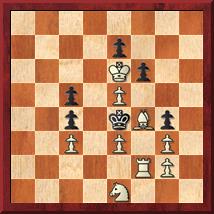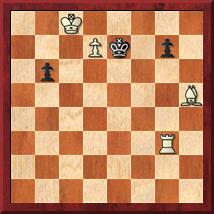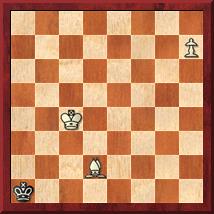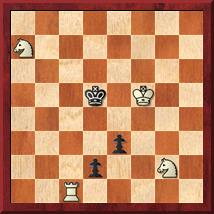Based on my research into chess aesthetics that goes back about a decade, I have come to the conclusion that beauty is indeed perceived by both composers and chess players who possess a certain degree of domain competence. Composers and players of some experience, not necessarily experts, are therefore quite likely not unfamiliar with the concept of beauty in the game. Examples of beautiful games include ‘The Immortal Game’ (1851) which features massive material sacrifices by Adolf Anderssen for the checkmate, and Fischer–Petrosian (1959), which features four queens on the board. Compositions or chess problems, on the other hand, come in various forms or subtypes, e.g. three-movers, helpmates, endgame studies. These are usually expected to abide by certain composition conventions that might seem unusual or unnecessary to most players, e.g. no check or capture in the first move, possess variations that are consistent with the theme or idea, and no cooked problems, i.e. two possible first moves that win; a rarity these days thanks to computer chess engines. There are dozens of such conventions.
Beauty in an actual or real game is typically seen by experienced composers as being overly simplistic and lacking ‘depth’. Players, in general, tend to see compositions as largely esoteric and difficult to grasp with ease, i.e. they require time to understand and appreciate. If beauty were measured by the amount of enjoyment or satisfaction its perception yields to observers, it is difficult to say if there would be any difference between players and composers given their respective interests. In order to bridge this gap and bring beauty to the masses, so to speak, I would like to introduce the concept or domain of ‘chess constructs’. A chess construct is technically a composed chess problem with a stipulation such as “White to play and mate in three moves against any defense”, which is the same as a traditional composition of this type would have.
However, a construct differs mainly in that it need not necessarily conform to the conventions that govern chess compositions, particularly of the class that get published or win composition tournaments. Constructs differ from real games mainly in that the initial position is usually economical, e.g. no unnecessary pieces on the board. One is unlikely to find the exact same thing in a real game. Yet chess constructs are also more ‘believable’ than traditional compositions as they are more likely to come about or be reachable in an actual game; especially in terms of the idea or theme behind the construct. So chess constructs can be seen as a sort of composition domain in itself, lying somewhere between real games and traditional compositions in form.
I am inclined to think this way because such positions – in my years of experience dealing with expert composers and expert players – tend to get ‘mixed reviews’. Expert players are quite often able to appreciate the beauty in constructs whereas expert composers tend to be less than impressed because constructs do not exhibit the ‘sophistication’ of some of the better traditional compositions they are used to seeing. In general, a chess construct:
- contains a stipulation;
- is economical;
- is somewhat interesting or educational;
- possesses some aesthetic value.
To further illustrate the differences between the three domains, Figure 1 shows a typical sequence take from a tournament game (Anderssen’s game at the point of interest), a chess construct (provided by me), and an award-winning composition. The solutions are provided at the end of the article.
|
|
|
|
|
Anderssen vs. Kieseritzky,
London, 1851
|
Azlan Iqbal, 2014
White to play and mate in 3
|
M. Myllyniemi, Suomen Shakki, 1952. White to play and mate in 3
|
Figure 1. A real game sequence, a chess construct and a traditional chess composition
Interestingly, Anderssen’s game could probably have been won in a less spectacular fashion than what actually occurred. Yet this does not detract very much from its perceived aesthetics, something unforgiveable in a traditional composition or study. The chess construct may appeal aesthetically to players and some composers, but it was not taken from an actual game, even though it looks like it might have come from an actual endgame. It also falls short of the ‘depth’ typically expected from the best three-movers ‘suitable for publication’, as experienced composers often put it. This depth can be seen in the traditional composition provided, even though it is probably more difficult to digest than the real game and construct.
Indeed for each category there is a whole spectrum which may overlap with that of another category, but it is hoped the distinction, in general, is clear. Figure 2 shows three more constructs of mine which are neither taken from real games nor worthy of a traditional composition award. The reader, regardless of chess skill and at the risk of some aesthetic satisfaction, is invited to solve them on their own, as chess constructs are not as complicated as a traditional chess problems of the published variety.
|
|
|
|
|
Azlan Iqbal, 2014
White to play and mate in 3
|
Azlan Iqbal, 2014
White to play and mate in 3
|
Azlan Iqbal, 2014
White to play and mate in 3
|
Figure 2. Three more examples of chess constructs
Chess constructs are easier for people from both groups (i.e. players and composers) to compose and more instructive as an educational tool for non-experts. The beauty of a chess construct is that just about any chess enthusiast can create one, without needing to be an experienced player or expert composer. They just need a basic idea or tactic in mind and from there figure out where the pieces need to be without any concerns about conformity to conventions. That is all. (Of course, it might be prudent to check with a computer chess engine that there are no hidden defenses by Black.) Perhaps one day we shall see published books full of unique, entertaining and educational constructs contributed to largely by regular chess players and ‘amateur’ composers.
Solutions
Select games from the dropdown menu above the board
Win a prize, submit your own chess construct
Like to try your hand at composing a chess construct? If you come up with a position that satisfies the definitions above then you can submit it to the author – only three-movers for the time being, and in PGN please. Dr Iqbal will decide which of the constructs, sent in before the 14th of July, were the best. There will be a special prize of a chess program signed by most of the best players in the world for the very best composition, and two software prizes – a Fritz Trainer of your choice – for the runners up. Naturally most of the constructs will be published on our news page.
Previous articles by the author
-
9/2/2009 – Can computers be made to appreciate beauty?
Or at least to identify and retrieve positions that human beings consider beautiful? While computers may be able to play at top GM level, they are not able to tell a beautiful combination from a bland one. This has left a research gap which Dr Mohammed Azlan Mohamed Iqbal, working at Universiti Tenaga Nasional, Malaysia, has tried to close. Here's his delightfully interesting PhD thesis.
-
12/15/2012 – A computer program to identify beauty in problems and studies
Computers today can play chess at the grandmaster level, but cannot tell a beautiful combination from a bland one. In this research, which has been on-going for seven years, the authors of this remarkable article show that a computer can indeed be programmed to recognize and evaluate beauty or aesthetics, at least in three-move mate problems and more recently endgame studies. Fascinating.
-
2/2/2014 – A new, challenging chess variant
Ever since desktop computers can play at its highest levels and beat practically all humans, the interest of the Artificial Intelligence community in this game has been sagging. That concerns Dr Azlan Iqbal, a senior lecturer with a PhD in AI, who has created a variant of the game that is designed to rekindle the interest of computer scientists – and be enjoyable to humans as well: Switch-Side Chain-Chess.
- 5/11/2014 – Kasparov in Malaysia
He was mobbed, but in a good way: a large number of chess fans and autograph hunters sought close contact to the legendary World Champion, who officiated the opening of the PMB National Age Group Championship 2014, and took time to discuss a variety of topics with an expert on aesthetics-recognition technology in chess, our author Dr Azlan Iqbal – who sent us a big pictorial report.






























